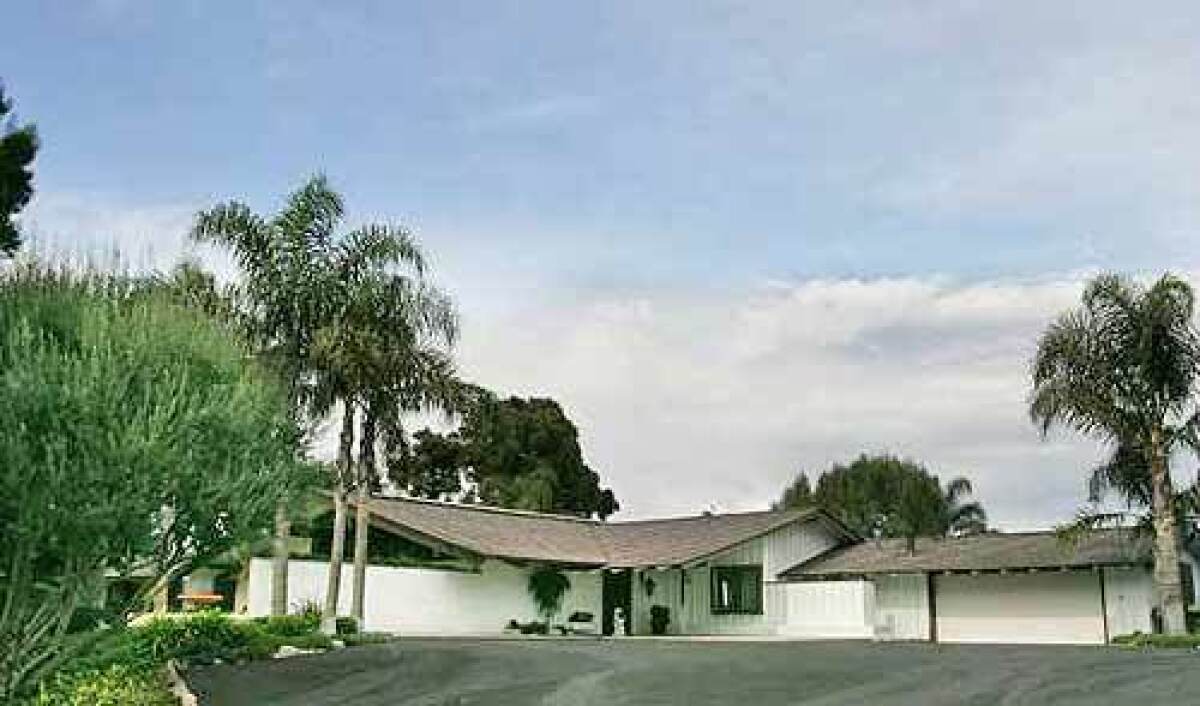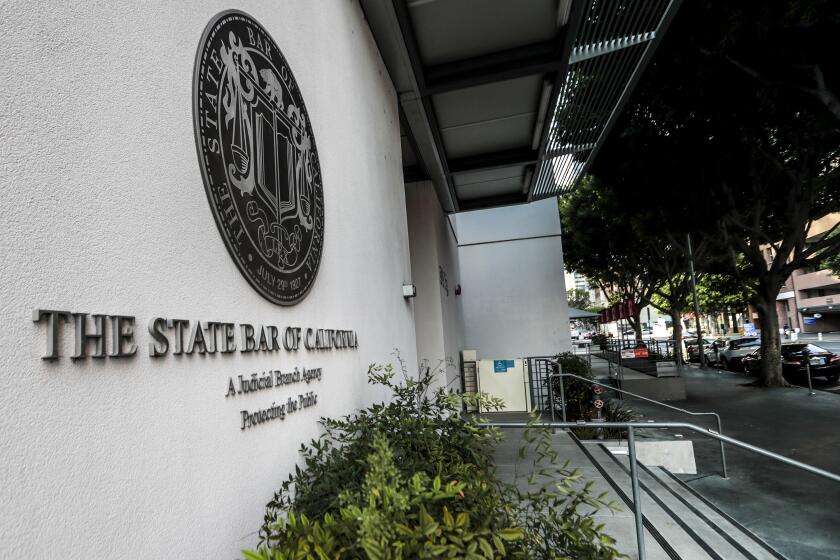The once and future ranch

- Share via
ITS low-slung frame sprawled across plains and valleys of a more open landscape. The single-story footprint didn’t boast, or point skyward like the self-assured colonial or Victorian. It offered a comfortable relationship with the climate and surrounding flora, and a democratic, open floor plan; it didn’t section off areas into servants quarters or announce visitors in grand foyers. It was modern without being Space Age, modest without being plain, evoking history without being mere nostalgia.
If a style of residential architecture can symbolize an era, the ranch house became the iconic American home in the period from roughly 1945 to 1970: By some estimates, 70% of American homes built in the 25 years after World War II were ranch houses.
The Chicago area, where the rancher evolved out of Frank Lloyd Wright’s Prairie house, and the desert Southwest, where the working ranch provided inspiration, were important centers.
But the ranch house had a special role in Los Angeles, and the fruit orchards and bean fields that fell away from the city soon became ideal laboratories for the style — making L.A. the unofficial capital of what would be called the “California-style house.”
Postwar Los Angeles, with its forward-looking community of architects and developers, took the ranch to its apogee, and Hollywood, with its powerful image-making ability, helped spread the word. Now, because of its deep-rooted connections, the Los Angeles area is reasserting its role in the style’s revival.
To author and suburban bard D.J. Waldie, the ranch house is downright fashionable. “It’s the late 20th century version of the Arts and Crafts bungalow,” he says. “Some of that fussiness is being transferred to ranch house culture.”
Alongside the fussiness is a growing preservationist movement. “The ranch house is the next emerging residential preservation issue,” says Ken Bernstein, director of preservation issues for the Los Angeles Conservancy. “And while some have come to accept the high-end Modernist home, the ranch house is only now gaining recognition and acceptance.” In 2002, the conservancy fought to save a Cliff May Experimental House in Sullivan Canyon. And the chair of the group’s Modern Committee, Adriene Biondo, lives in a Joseph Eichler ranch house.
There is “typically a 40- or 50-year lag between the time when something is popular and when it’s rediscovered,” says Kenneth Breisch, professor of architecture and preservation at USC.
“My students, who look back nostalgically at the ranch house because it’s from another era, are doing projects and research papers on the ranch house,” he says.
Jim Brown, a South Pasadena photographer, and his wife, Michelle Gringeri-Brown, both grew up in postwar ranches in the Southland in the ‘50s and ‘60s. “And like everyone else, we took them for granted,” Brown says. “We moved on and embraced bungalows. Ranches were so ubiquitous. And because it was the house that a lot of boomers had grown up in, it was my folks’ house. And what could be more uncool than your folks’ house?”
But the experience of the Browns, who came to value the ranch’s low-key beauty and its indoor-outdoor living, shows the style’s reformation. Brown and Gringeri-Brown, a former editor of American Bungalow, now publish the year-old magazine Atomic Ranch, which aims to do for the rancher what Taschen Books’ 2002 release did for the Case Study Houses: frame the style in a hip, retro package, nearly fetishizing its sharp angles, post and beam ceilings, and sliding glass doors.
“The people we photograph are in their 30s and 40s,” says Brown, a good-humored and enthusiastic guy in his early 50s. “They have hip, cool professions; they’re animators or musicians.” He calls the process in which people reject their parent’s era but embrace the previous generation “the grandma effect.”
THE ranch house, because of the era in which it developed, had its meaning made largely by the mass media. It was one of the first all-American architectural forms and, arguably, the first form that developed alongside its own mirror image.
The ranch’s origins are tied up with larger trends in popular culture. Around 1930 — about the same time early ranch houses went up in the Palos Verdes Peninsula and Palm Springs — the country became increasingly conscious of its history and vernacular traditions, especially its Western heritage. Movies by John Ford showed lanky cowboys retiring to their ranches after a day riding the range, Bob Wills and His Texas Playboys had begun to record, and even composer Aaron Copland became fascinated with Billie the Kid.
Some scholars argue that the survival of the ranch house depended on elements of Western pop culture such as dude ranches, Western swing music and Hollywood films. “If it had not been for their new role, and their glorification in the movies, ranches might well have disappeared from the landscape,” architectural historian Alan Hess writes in his book “Rancho Deluxe,” which looks at the ranch-style homes of Buffalo Bill, Will Rogers and Gene Autry, whose publicity helped whet the nation’s appetite.
“Had that technology not existed, the ranch house would most probably have gone the way of log cabins and sod huts,” Hess writes, “a colorful historical memory but no longer a living architecture.”
The technology of film, and the nation’s patriotic tone during and after the war, filled the humble tract ranch with positive connotations. “In the ‘50s, say ‘ranch’ and it would bring up all these associations,” says Hess. “Self-reliance, owning your own property, living in nature. And the people who lived in them were often pioneers in the development of the suburbs. Good architects caught all that and translated it into design.”
But even as they were being built all over the country, and appearing in countless publicity photographs and magazine covers shot in Southern California, ranchers were not as visible on television as the multi-story colonials that housed many sitcom families. Mr. Ed and his owner lived in one, with stable attached, as did the family in “Green Acres” and other rural shows; Lucy and Ricky Ricardo briefly lived in a ranch house during a sojourn to the wilds of Connecticut. In the ‘60s, Dick Van Dyke’s TV-writer character lived in a New Rochelle, N.Y., rancher, with his wife, played by Mary Tyler Moore (who currently lives in a San Fernando Valley rancher). But they were hardly ubiquitous.
“On TV, most of the houses went up, just as they did in reality,” says Mark Bennett, an L.A. artist whose work concerns the floor plans of sitcom houses. He laments that the sitcom that celebrated 1950s Southern California — “Happy Days” — wasn’t set in a ranch house. “There were several great shows that had incredible ranch houses, but they didn’t last more than a season or so,” he says.
The ranch’s use in films, outside the Western genre, was often for parodic or sardonic purposes: By 1962, the ranch house played a starring role in “Bachelor in Paradise,” in which Bob Hope, as a rich Francophile playboy, is exiled to a squeaky clean Valley ranch tract because of unpaid taxes. After condescension early in the film — “What do you call this style? Early Disneyland?” — Hope’s character comes to embrace the community and its suburban mores.
“Back to the Future” (1985), shows how flexible the ranch can be. At the film’s beginning, the family ranch house is dingy and unimpressive, housing a clan of underachievers. “We wanted [Crispin Glover’s] George McFly to be a kind of working stiff, with a family that lives rather modestly,” says Lawrence Paull, the film’s production designer. When Michael J. Fox’s character goes back to his hometown in 1955, the ranch development he grew up in is just being built.
By the end of the film, due to the meddling of Fox’s character, the family has become vastly more successful — and their rancher dressed up quite nicely. “It’s the American dream,” Paull says. “The house became a symbol of that.”
The ranch house takes on a strikingly ambivalent role in “Boogie Nights” (1997): It’s the setting, briefly seen, for the Mark Wahlberg character’s middle-class Torrance family, and it’s the bacchanalian abode of Burt Reynolds’ millionaire porn director.
The parody was gentler in last year’s Pixar animated film “The Incredibles,” but the Eichler-like ranch house still symbolizes the suburban conformity to which this superhero family has been confined.
BESIDES all the cultural baggage, the ranch house boomed in Southern California partly because the region was a hotbed of talent — and talent with an adventurous streak — in midcentury.
“This was the mother lode of experimentation in architecture, especially in residential architecture,” says John English, an architectural preservationist. “Here is where the boundaries were being pushed, and here’s where they got to things first.”
On a clear summer afternoon, Hess, the architectural historian, is witnessing evidence of that talent. He’s in Panorama City, driving through a postwar ranch tract, full of L-shaped houses with low-pitched roofs and visible garages, that he finds “stirring.” The individualism of each home is subtle: a hint of brick, a dove house, board-and-batten siding, wood porch posts. (By the end of the afternoon in the Valley, he’ll have seen ranches with hints of New Mexican, gingerbread and Japanese styles.)
Los Angeles, he points out, was a national force in marketing and advertising. “People outside Southern California saw these things as not quite respectable, because they were about popularization and the mass audience,” Hess says. “But that’s what Southern California is all about.”
Hess’ 2005 book, simply titled “The Ranch House,” locates the rancher in the history of architectural Modernism, calling it “a moderate modernism” without the austerity of the European vanguard or the sharp edges of the Case Study Houses.
“In Europe they were trying to create decent affordable housing,” he says of the often utopian attempts by Modernists Le Corbusier or Water Gropius. “In America, they were trying to sell it. Architects and developers realized Americans wanted individuality, and they found a way to mass-produce individuality.” Besides the architects, he emphasizes developers such as Henry J. Kaiser.
“Living in a ranch house,” says author Waldie, “would have connoted an ambivalence about Modernism: On one hand you’ve purchased a home that is on the cutting edge of domestic architecture of the period,” stocked with all the modern conveniences. “But the house also comes with associations of American values, and a suggestion that the best way to live is on the open landscape of America.”
Every ranch enthusiast has a favorite architect or designer. Some go for the upscale Modernist Eichler, others for the rustic-elegant William Wurster, still others for overlooked figures like the contemporary-style Edward Fickett.
But all acknowledge that the genius of mass-produced individualism was May, a San Diego big-band leader and furniture designer who never got an architectural degree but lifted the rancher to great expression.
Waldie says of the often anxiety-ridden search for affordable housing, “Cliff May took the angst out.”
May, a sixth-generation Californian, produced about 20,000 houses, many of them in the Southland but ranging as far as Italy and Australia. His custom homes were the higher end of the style, with exposed wood-beam ceilings, ranch-style gates and lots of hand-carved wood, but he’s also known for tract developments that brought smaller ranchers — about 950 square feet — into range for blue-collar workers.
A few years after building his first house in San Diego in 1931, May moved to Los Angeles because of the wealth of clients — and because the city’s status as a media center gave him a bullhorn.
Much of May’s influence came from designing houses like his ranchos, homes in Pomona and Anaheim and Long Beach, which were closer to Spanish-colonial cattle ranches than the more clean-lined style that would develop later. May was, like “Ramona” author Helen Hunt Jackson, a genius at packaging California history. “The early Californians had the right idea,” May said in a 1936 interview. “They built for the seclusion and comfort of their families, for the enjoyment of relaxation in their homes. We want to perpetuate those ideas of home building.”
Over time, some of the historical roots dropped out of his designs as he embraced the sleeker profile of Modernism, as in his Eshelman-Bemis house, a 1963 Rolling Hills rancher with a sweeping roof, an entire wall made of glass and an open interior that frames views of the Pacific Ocean.
THOUGH the ranch house’s roots go as far back as the working cattle ranch of the 19th century, even to the Mexican adobe haciendas built at the beginning of Spanish colonialism, they don’t all have wagon wheels and cactus gardens. The style ranges from deliberately Western — like some of May’s custom designs — to structures whose simple and clean lines, extensive glass and rejection of ornament are positively modern. Between these and the suburban developments, which can often be merely generic, the rancher is a difficult style to characterize.
Generally, the ranch’s internal spaces flowed into one another in an unstructured way. USC’s Breisch says they fit the informal tone of post-World War II living.
“It seems to have pivoted on the labor of housewives,” Waldie says of the open plan. “It only works if the housewife is standing in the kitchen and can survey her realm from the command center.”
The rancher was one of the first middle-class homes to have a separate master bedroom for the parents. “The family room on the other hand brought everyone together for hobbies, cooking, TV and homework,” says Hess. “The architecture threw family members together by design, but also gave them some needed privacy. Pretty ingenious.”
And the home’s L or U shape, typically bent around a backyard with kidney-shaped pool and barbecue, encouraged relaxed family togetherness and reflected then-progressive ideas about healthy family life.
Whatever security or prosperity was found inside a ranch house, though, it had little to say to public spaces like streets or parks. “It literally turned its back on the street,” says Waldie. “It implied that life was lived only in private. That’s the most pernicious effect of the ranch house ethos.”
Most revolutions fade out, or wear out their welcome, and the ranch fell on hard times as the 1970s began. The rising cost of land, Hess explains, made these rambling homes more expensive, and the energy crisis made it pricey to heat a sprawling one-story with large glass windows. Ranchers were built less and less, and some owners began knocking them down to build flashier homes.
“There wasn’t much street presence to a ranch house,” says Louis Wasserman, the author, with M. Caren Connolly, of the recent book “Updating Classic America: Ranches.” “People started to convert their ranches into Tudors. They wanted street presence, and the ranch was anti-street presence.”
Part of it too was as subject to fashion as changing hemlines: The ranch house was not only a midcentury style, it was also a style that had become positively ubiquitous.
The backlash against ranchers continues in some parts of the country, where they’re being ripped down to make room for McMansions and pseudo-Tuscans. It’s a contrast to the days when fabulously rich and famous Southlanders such as John Paul Getty and Will Rogers enjoyed the informal living and egalitarian symbolism of the rancher.
When Elvis Presley made his first fortune in the 1950s, as scholar Karal Ann Marling points out in her cultural history “As Seen on TV,” he bought three Cadillacs for himself — and a ranch house in suburban Memphis for his mother. Ronald Reagan, as an actor and later as president, lived in a series of ranch houses as well as, famously, one working ranch. Hollywood figures such as Robert Wagner, Cybill Shepherd and Dick Clark live in ranchers.
Once dismissed as a conformist suburban artifact like white bread and kidney-shaped pools, the ranch house has become the kind of house that attracts cultists, preservationists and scholarly attention. “And what happens to taste in Los Angeles influences what people do elsewhere in the country,” says Hess.
In fact, Atomic Ranch publisher Brown says he and his wife would move out of their 1920s Craftsman in a second if they could find a Cliff May rancho they could afford. These days they are, apparently, not alone.
Scott Timberg can be reached at [email protected].
More to Read
Sign up for Essential California
The most important California stories and recommendations in your inbox every morning.
You may occasionally receive promotional content from the Los Angeles Times.










